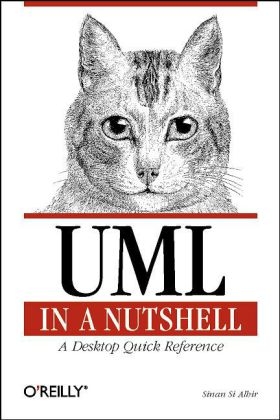
UML in a Nutshell
O'Reilly Media (Verlag)
978-1-56592-448-2 (ISBN)
- Titel ist leider vergriffen;
keine Neuauflage - Artikel merken
Modeling languages have been used by system developers for decades to specify, visualize, construct, and document systems; rough sketches using stick figures and arrows and scribbled routing conditions go back still further. But the Unified Modeling Language (UML), for the first time in the history of systems engineering, gives practitioners a common language that applies to a multitude of different systems, domains, and methods or processes. It does not guarantee project success, but enables you to communicate solutions in a consistent, standardized, and tool-supported language. All indications suggest that the industry is rushing to the UML. Created by leading software engineering experts Grady Booch, James Rumbaugh, and Ivar Jacobson (now of Rational Software Corporation), and accepted as a standard by the Object Management Group (OMG) in 1997, the language has already achieved more success than any previous contenders. With a firm conceptual and pragmatic basis, it is well suited to supporting projects in modern languages like C++ and Java. And standardization lays the groundwork for tools as well as standard methods or processes.
This book presents the UML, including its extension mechanisms and the Object Constraint Language (OCL), in a clear reference format. For those new to the language, a tutorial quickly brings you to the point where you can use the UML. The book is concise and precise, breaking down the information along clean lines and explaining each element of the language. Introductory chapters also convey the purpose of the UML and show its value to projects and as a means for communication. Topics include: The role of the UML in projects The object-oriented paradigm and its relation to the UML Tutorial with realistic examples An integrated approach to UML diagrams Class and Object, Use Case, Sequence, Collaboration, Statechart, Activity, Component, and Deployment Diagrams Extension Mechanisms The Object Constraint Language (OCL)
Sinan Si Alhir has breadth and depth in all phases of the systems development life cycle. With experience in high-level and low-level project work, and his broad and deep knowledge of technology and methodology, he focuses on delivering quality solution-oriented results within various application domains, using a multitude of technologies and methods. While tremendously enjoying his profession, Sinan Si Alhir also enjoys being intellectually and artistically active via reading and writing poetry and philosophy and listening to music, and he enjoys being physically active via walking and jogging. Furthermore, he is motivated by the works of Edgar Allen Poe, Leo Tolstoy, Rene Descartes, Georg Hegel, Immanuel Kant, Sigmund Freud, and others. But above all, it is his family that keeps him balanced, fulfilled, content, and makes it all worthwhile. Sinan Si Alhir maintains an informative Web site at http://home.earthlink.net/~salhir/
Preface. Part I: Introducing the Unified Modeling Language. Chapter 1-Introduction What Is the Unified Modeling Language? What Constitutes the Unified Modeling Language? The Evolution of the Unified Modeling Language. Chapter 2-The Big Picture Problems, Solutions, and Problem Solving Problems and Solutions Problem Solving Chapter 3-Object Orientation Worlds Paradigms Object Orientation Objects and Classes Links and Associations Scenarios and Interactions Variations and Summary Part II: Using the Unified Modeling Language. Chapter 4-A Unified Modeling Language Tutorial The Unified Modeling Language Diagrams Use Case Diagrams Class Diagrams Object Diagrams Sequence Diagrams Collaboration Diagrams Statechart Diagrams Activity Diagrams Component Diagrams Deployment Diagrams Other Notation and Information Chapter 5-The Unified Modeling Language Architecture Metamodel Architectural Views and Diagrams Mechanisms Problems, Solutions, and Problem Solving Part III: The Unified Modeling Language Quick Reference Chapter 6-Diagramming and Model Organization Diagrams Notes Packages The Role of Tools Chapter 7-Class and Object Diagrams Classes Objects Associations Links Compositions Chapter 8-Use Case Diagrams Actors Use Cases Communicates Relationships Extends Relationships Uses Relationships Chapter 9-Sequence Diagrams Interactions Class Roles Lifelines Activations Messages. Chapter 10-Collaboration Diagrams Collaborations Association Roles Multi-roles Message Flows. Chapter 11-Statechart Diagrams States Transitions Events Actions Chapter 12-Activity Diagrams Swimlanes Action States Action Flows Object Flows Chapter 13-Component Diagrams Components Development-Time Relationships Calls Relationships. Chapter 14-Deployment Diagrams Nodes Communication Relationships Run-Time Relationships Supports Relationships Becomes Relationships Chapter 15-Extension Mechanisms Stereotypes Properties Constraints Tagged Values UML Extension for the Objectory Process for Software Engineering UML Extension for Business Modeling. Chapter 16-The Object Constraint Language Expressions Object Properties Collections Standard Types References World Wide Web Resources Books Index
| Erscheint lt. Verlag | 27.10.1998 |
|---|---|
| Zusatzinfo | illustrations |
| Verlagsort | Sebastopol |
| Sprache | englisch |
| Maße | 153 x 229 mm |
| Gewicht | 470 g |
| Einbandart | kartoniert |
| Themenwelt | Mathematik / Informatik ► Informatik ► Programmiersprachen / -werkzeuge |
| Informatik ► Software Entwicklung ► Objektorientierung | |
| ISBN-10 | 1-56592-448-7 / 1565924487 |
| ISBN-13 | 978-1-56592-448-2 / 9781565924482 |
| Zustand | Neuware |
| Haben Sie eine Frage zum Produkt? |
aus dem Bereich


